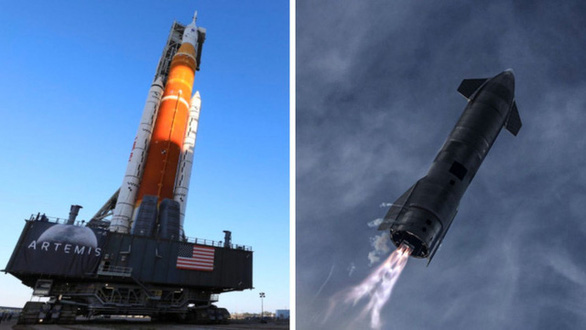NASA’s SLS super rocket ‘far behind’ SpaceX’s rocket?

NASA’s SLS super rocket and SpaceX’s Starship rocket – Photo: INTERESTING ENGINEERING
The comparison between the two rockets launched by SpaceX and NASA is so much that recent reports show that NASA officials are trying to “explain”. Technical news page – technology Interesting Engineering analyzed this event.
Which rocket is more powerful and more cost-effective?
The main difference between NASA’s SLS super rocket and SpaceX’s rocket is perhaps most evident in NASA’s own plans for their upcoming Artemis Moon missions.
The Artemis I and II missions will orbit the Moon using the SLS super rocket. While Artemis III’s Moon landing will be carried out using a (reusable) Starship rocket to help astronauts research and then return them to Earth.
At just under 100m tall, the SLS is a giant launch rocket, albeit smaller than SpaceX’s full Starship, which has a booster attached, measuring 120m. Starship is a fully reusable super-heavy rocket that is being developed and manufactured by SpaceX.
The SLS generates 9.5 million lbs of thrust (4,310 tons) and carries a payload of 190,000 lbs (86 tons) into low Earth orbit (LEO).
The Starship generates 17 million lbs of thrust (7,710 metric tons), can launch 300,000 lbs (150 metric tons) and is reusable.
Which rocket got to orbit first?
Both SLS and Starship appear to be on the verge of reaching orbit, although both projects have been plagued with recent setbacks.
Just a short time after SpaceX CEO, billionaire Elon Musk, said that Starship could make its first flight in orbit as soon as this May, the US Federal Aviation Administration (FAA) has announced announced that it will delay Starship’s environmental impact assessment until May 31.
This is the latest in a series of FAA delays to Starship. This is necessary for the FAA to have a full assessment of Starship before it can be launched into orbit.
NASA’s SLS launch also encountered a series of delays. SLS was recently launched on the launch pad, and then again return to “production site” for analysis after some problems.
SLS can only launch into orbit after a successful refueling exercise. Three attempts to conduct this exercise have so far failed, and the latest update shows that the SLS will launch no earlier than August 2022.
However, since SpaceX is awaiting an environmental review by the FAA, it wouldn’t be surprising to see SLS in orbit first, despite its recent string of failures.
What are the biggest problems with SLS?
NASA’s SLS is the space agency’s most iconic rocket.
Although the SLS is slightly lower (100m) in height than the Saturn V rocket (111m) that made the Apollo 11 mission, it can still carry the same 7.5 million lbs (3,400t) payload as that of the Apollo 11 mission. Saturn V. So why has this project received so much criticism in recent months and years?
This is largely due to the high cost of SLS, as well as the recent series of highly publicized failures.
Designed in partnership with Boeing, the SLS has so far cost nearly three times the expected $10 billion development cost, when it was first announced in 2011.
In contrast, NASA has given SpaceX at least $3 billion for the launch of Starship. Although it can develop reusable rockets, SpaceX has also had to rely on profits from satellite launches and the Starlink Internet service.
Furthermore, NASA estimates that an SLS launch will cost around $2 billion, while billionaire Musk claimed – in his latest Starship presentation – that a Starship mission could cost a relatively low $1. million dollars.
That’s largely thanks to the huge benefit of rocket reusability, which reduces launch costs.
However, despite the criticism, NASA officials stated that the SLS program was proceeding as planned.
at Blogtuan.info – Source: tuoitre.vn – Read the original article here



